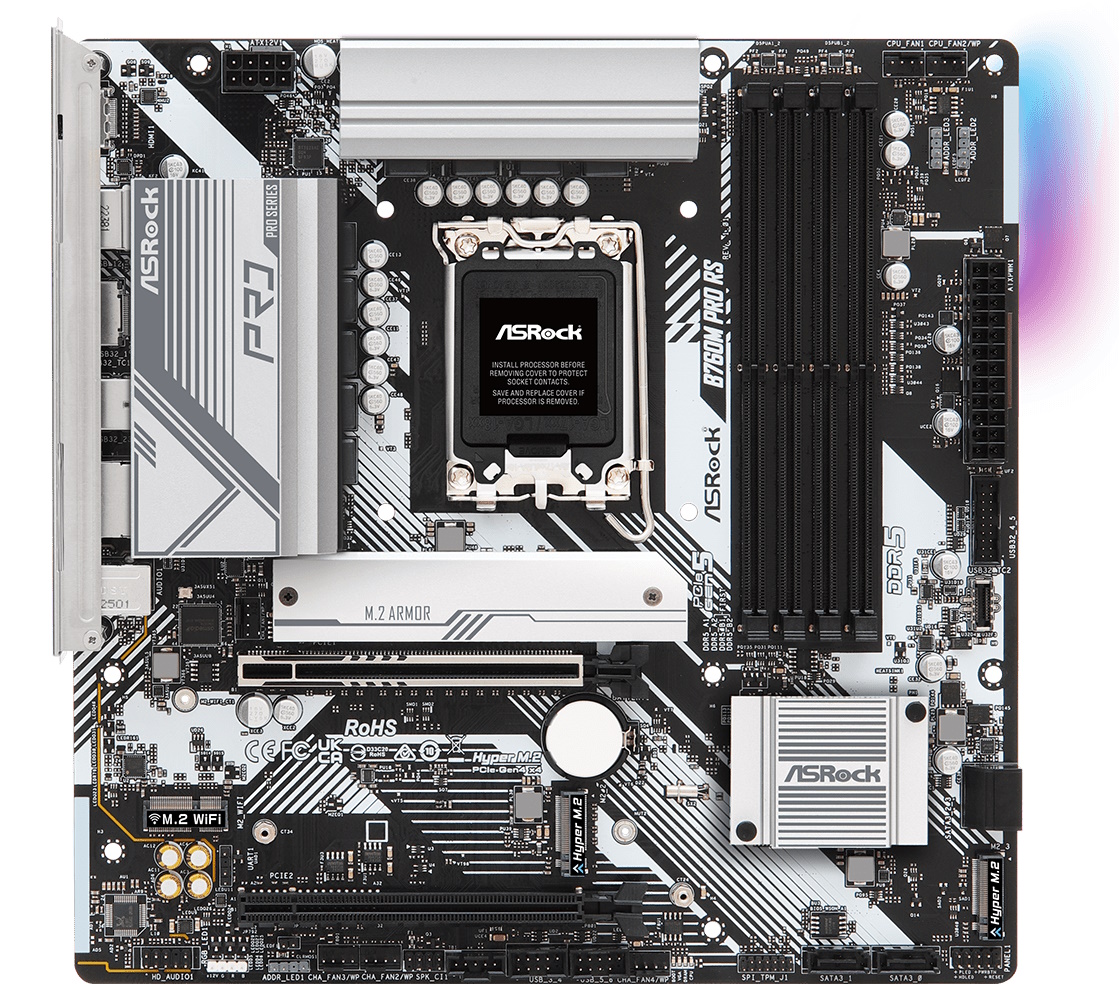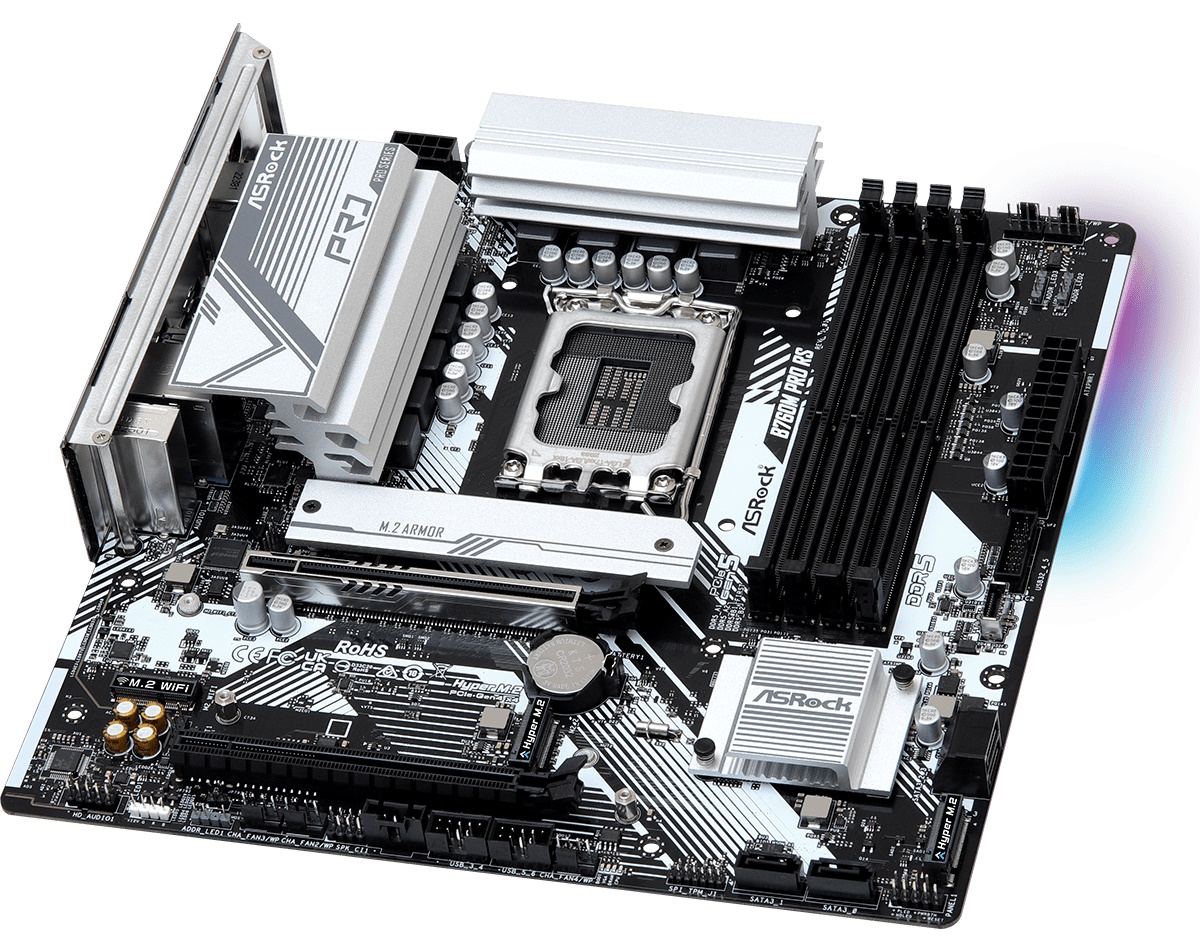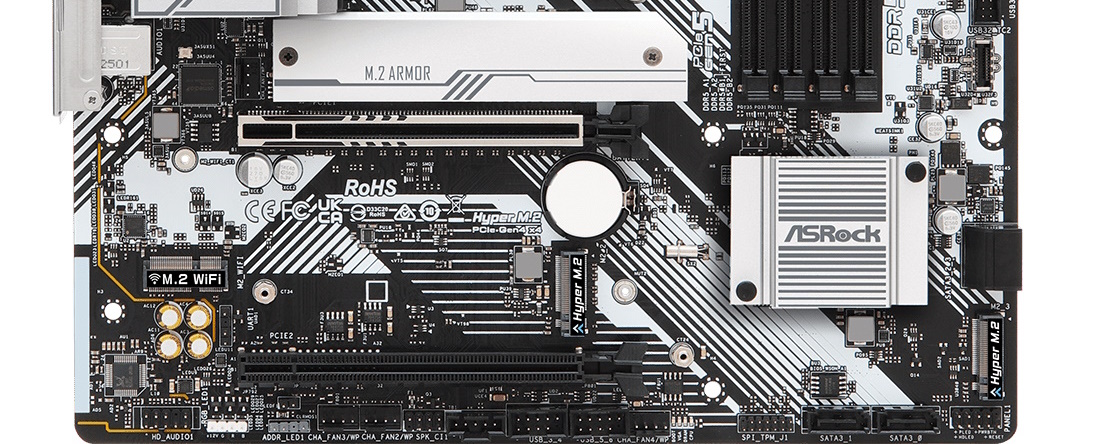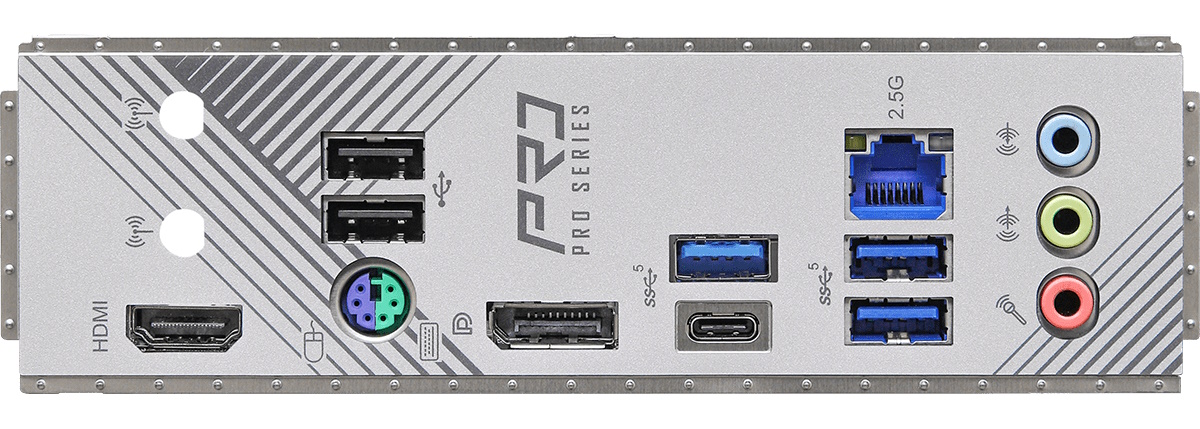Tom's Hardware Verdict
Priced at $124 on Newegg, the ASRock B760M Pro RS is a worthy Intel option in the budget Micro ATX space. You get ample storage options, but some users may feel limited by the rear IO USB port count (five) and speeds (5 Gbps).
Pros
- +
Budget Micro ATX pricing
- +
Ample storage (3x M.2 sockets, 4x SATA)
Cons
- -
Only Five Type-A ports on rear IO
- -
Lacks 10 Gbps or faster USB ports
- -
Performance limited to Intel specs by default
- -
No integrated Wi-Fi
Why you can trust Tom's Hardware
The ASRock B760M Pro RS is a Micro ATX motherboard that won’t clean out your wallet. Priced at $123.99 at Newegg, you get full support of 12th-14th-gen Intel processors (14th-gen with a BIOS update), ample storage options, 2.5 GbE, a PCIe 5.0 slot, sufficient power delivery, and a simple black-and-gray appearance that’s sure to blend in with whatever themed build you may have.
ASRock has a complete product stack of B760 boards. In fact, it has a whopping 26 B760-based boards listed on its website - many of which are Micro ATX form factor. There are two Mini-ITX boards and a few ATX boards, but the vast majority are Micro ATX, all designed for budget builds. If you can’t find something you like in this expansive list of B760 SKUs, you’re either looking at the wrong chipset or being too particular.
Performance-wise, the B760M Pro RS did well compared to other boards that also more closely follow intel specifications. As we’ll see later in the VRM testing, the board allowed for a 250W boost out of the box and then settled to 125W for the remainder of the stress testing. Compared to boards that allow more power use, it is slower, but you can quickly work around this by adjusting the power limits. Outside of that, it was a competent gamer and did well in tasks that didn’t involve pushing the CPU hard.
Below, we’ll dig into the details of the board and see whether it deserves a spot on our Best Motherboards list. Before we get into our testing and board specifics, though, we’ll start by listing the specifications from ASRock’s website.
Specifications: ASRock B760M Pro RS
| Socket | LGA1700 |
| Chipset | B760 |
| Form Factor | Micro ATX |
| Voltage Regulator | 9-Phase (7x 50A Dr. MOS MOSFETs for Vcore) |
| Video Ports | (1) HDMI (v2.1) |
| Row 5 - Cell 0 | (1) DisplayPort (v1.4) |
| USB Ports | (1) USB 3.2 Gen 1, Type-C (5 Gbps) |
| Row 7 - Cell 0 | (3) USB 3.2 Gen 1 (5 Gbps) |
| Row 8 - Cell 0 | (2) USB 2.0 (480 Mbps) |
| Network Jacks | (1) 2.5 GbE |
| Audio Jacks | (3) Analog |
| Legacy Ports/Jacks | ✗ |
| Other Ports/Jack | ✗ |
| PCIe x16 | (1) v5.0 (x16) |
| Row 14 - Cell 0 | (1) v3.0 (x4) |
| PCIe x8 | ✗ |
| PCIe x4 | ✗ |
| PCIe x1 | ✗ |
| CrossFire/SLI | AMD Crossfire |
| DIMM Slots | (4) DDR5 7200+(OC)*, 192GB Capacity |
| Row 20 - Cell 0 | *1DPC 1R Up to 7200+ MHz (OC), 4800 MHz Natively. |
| Row 21 - Cell 0 | 1DPC 2R Up to 6000+ MHz (OC), 4400 MHz Natively. |
| Row 22 - Cell 0 | 2DPC 1R Up to 5600+ MHz (OC), 4000 MHz Natively. |
| Row 23 - Cell 0 | 2DPC 2R Up to 4800+ MHz (OC), 3600 MHz Natively. |
| M.2 Sockets | (3) PCIe 4.0 x4 (64 Gbps) / PCIe (up to 80mm) |
| SATA Ports | (4) SATA3 6 Gbps (Supports RAID 0/1/5/10) |
| USB Headers | (1) USB v3.2 Gen 1, Type-C (5 Gbps) |
| Row 27 - Cell 0 | (1) USB v3.2 Gen 1 (5 Gbps) |
| Row 28 - Cell 0 | (2) USB v2.0 (480 Mbps) |
| Fan/Pump Headers | (6) 4-Pin (CPU, CPU/Water Pump, Chassis) |
| RGB Headers | (3) 3-pin ARGB |
| Row 31 - Cell 0 | (1) 4-pin RGB |
| Diagnostics Panel | ASRock Post Status Checked |
| Internal Button/Switch | ✗ |
| SATA Controllers | ✗ |
| Ethernet Controller(s) | (1) Realtek Dragon RTL8125BG (2.5 GbE) |
| Wi-Fi / Bluetooth | ✗ |
| USB Controllers | Asmedia ASM1074 |
| HD Audio Codec | Realtek ALC897 |
| DDL/DTS | ✗ / ✗ |
| Warranty | 3 Years |
Inside the Box of the ASRock B760M Pro RS
Inside the retail packaging, below the motherboard, ASRock includes a few accessories to get you started. You get two SATA cables, a Wi-Fi antenna, screws for M.2 sockets, and the manual. Although there isn’t much here, it’s appropriate and comparable for its price point.
Design of the Pro RS



Our Micro ATX motherboard is built on a black-and-white-patterned, 6-layer PCB with a semi-gloss finish. All the heatsinks are silver, which provides nice accents for the Race Sport theme (what the RS stands for). Those who want RGB lighting have to buy their own and add them to the onboard headers, as the Pro RS does without. Mainstream DIYers will have few issues integrating this board into any build plans, but it doesn’t provide much bling out of the box.
Beginning our board tour in the upper-left corner, we spy a single 8-pin EPS connector that powers the processor. To the right and below are medium-size heatsinks that keep the paltry but sufficient power bits below running within specification. They aren’t enormous heatsinks, but they did their job during stress testing using the Intel defaults for power and performance.
Get Tom's Hardware's best news and in-depth reviews, straight to your inbox.
Moving past the socket area, we run into four DRAM slots with locking mechanisms on both sides. ASRock lists support up to DDR5-7200+ (OC), which is plenty fast for the budget platform it's built on. We didn’t have any issues with our DDR5-6000 kit, but our DDR5-7200 kit, which was not on the QVL, didn’t want to work on this system. As always, stick to the Memory QVL list for assured compatibility.
At the top right corner, we run into our first two (of six) 4-pin fan headers: CPU_FAN1 and CPU_FAN2/WP. Each header supports PWM and DC-controlled devices. Power output varies with CPU_FAN1, supporting 1A/12W output, while the rest are 2A/24W. Fan control is managed through the BIOS or the A-Tune application. There are plenty of headers and enough output to run all your cooling off the motherboard.
Moving down the edge, we find the first two 3-pin ARGB headers, the other on the bottom edge, and a single 4-pin ARGB header. The Polychrome Sync application within the BIOS or the Windows-based application controls any attached RGB lighting. Both methods offer several canned styles and different speeds, but the full application in Windows gives you more options.
Continuing down the edge, we run into the 24-pin ATX connector to power the motherboard, a 19-pin front USB 3.2 Gen1 (5 Gbps) header, and a USB 3.2 gen 2 (10 Gbps) Type-C front panel connection as well.

Power delivery on the B760M Pro RS consists of nine phases, with seven dedicated to Vcore. Power moves from the 8-pin EPS connector onto a Richtek RT3628AE PWM controller. From there, it heads to the seven 50A Vishay SIC654 Dr. MOS MOSFETs. The 350A available is one of the lowest values I recall seeing in recent years, but it handled our flagship-class process fine using the Intel defaults. If you raise the factory limits, I suggest active cooling on the power delivery, especially when running CPU-heavy tasks on high-end processors.
On the bottom half of the board, we’ll start with the audio section on the left. Here we see the budget Realtek ALC897 7.1 channel audio codec, along with a few dedicated audio capacitors and, of course, the audio separation line. Even though it’s a dated codec, most users will be satisfied with the integrated audio. If not, you can always add your own with the available PCIe slots, or get some of the best PC speakers with a built-in DAC.
Speaking of PCIe slots, the B760M Pro RS has two. The top full-length slot uses reinforcement and is your primary for graphics, as it runs at PCIe 5.0 x16. The bottom full-length slot connects through the chipset and runs up to PCIe 3.0 x4 speeds. Assuming you have a video card, there’s only one slot for expansion, so keep that in mind when building.
Several M.2 sockets are available, including three Key-M sockets for storage and one Key-E for adding a CNVi-based Wi-Fi card (located above the audio section). The three for storage are all the same, supporting up to 80mm PCIe devices (not SATA-based M.2 modules) that run up to PCIe 4.0 x4 (64 Gbps) speeds. If you want a PCIe 5.0-based socket, you’re out of luck on this board. Remember that only one socket has a heatsink, so if you plan to run one of the faster PCIe 4.0 drives under heavy loads without throttling, ensure it’s under one.
Along the right edge, past the push-pin-connected chipset heatsink, you’ll find two (of four) SATA ports, with the others mounted vertically along the bottom edge. The B760M supports RAID0/1/5/10 modes with SATA-connected devices only.
Along the bottom edge are several headers, adding or supplementing functionality. This includes three more fan headers, two USB 2.0 headers, RGB and ARGB headers, a clear CMOS jumper, a Thunderbolt AIC header, the Post Status checker LEDs, the two vertically mounted SATA ports, and finally, the front panel headers for power/reset/LEDs, etc. Nothing major missing here, and nothing out of place.
Surprisingly, we don’t see this on many budget-class boards; the rear IO plate on the B760M Pro RS comes preinstalled on the motherboard. It has a gray background with Pro RS branding and darker gray lines that match the patterns on the board. As expected, there isn’t much back here, but it has what most people will need. There are six USB ports - 1x 3.2 Gen 1 Type-C, 3x 3.2 Gen 1 Type-A, and two USB 2.0 ports. That isn’t a lot, and the ports aren’t fast, topping out at 5 Gbps, so be sure you can work with what this board has. This won’t affect most devices except for external storage devices, so keep that in mind.
The HDMI and DisplayPort outputs cover integrated graphics. Between them is a legacy PS/2 port for a mouse or keyboard. The audio stack is a simple 3-plug configuration (in, out, microphone) with the Realtek 2.5 GbE port above it. ASRock has cutouts in the IO plate for Wi-Fi, should you add it down the road.
MORE: Best Motherboards
MORE: How To Choose A Motherboard
MORE: All Motherboard Content

Joe Shields is a staff writer at Tom’s Hardware. He reviews motherboards and PC components.
-
Amdlova Its insane to see these power loads... My build has same power full load cpu+vga+ screenReply -
35below0 "...the board allowed for a 250W boost out of the box and then settled to 125W for the remainder of the stress testing. Compared to boards that allow more power use, it is slower, but you can quickly work around this by adjusting the power limits. Outside of that, it was a competent gamer and did well in tasks that didn’t involve pushing the CPU hard..."Reply
This is why all manufacturers pushed unlimited power delivery. Every article is about MOAR POWER, and motherboards that "perform better" or are "slower" will lose sales.
Do we need this?
What matters most is features like USB ports and NVMe storage. RAM speed in MT/s is also useful as well as any compatibility problems.
Does it run processors that it's sensible to pair with? If yes, than the above is far more important than whatever results an i9 shows.
I wouldn't put an unlocked i5 into that motherboard, and in fact it would have been useful to test it with something like a 12400 or 13600K or similar. -
ocer9999 Reply35below0 said:"...the board allowed for a 250W boost out of the box and then settled to 125W for the remainder of the stress testing. Compared to boards that allow more power use, it is slower, but you can quickly work around this by adjusting the power limits. Outside of that, it was a competent gamer and did well in tasks that didn’t involve pushing the CPU hard..."
This is why all manufacturers pushed unlimited power delivery. Every article is about MOAR POWER, and motherboards that "perform better" or are "slower" will lose sales.
Do we need this?
What matters most is features like USB ports and NVMe storage. RAM speed in MT/s is also useful as well as any compatibility problems.
Does it run processors that it's sensible to pair with? If yes, than the above is far more important than whatever results an i9 shows.
I wouldn't put an unlocked i5 into that motherboard, and in fact it would have been useful to test it with something like a 12400 or 13600K or similar.
Yea, not quite sure who would run a i9 on this motherboard, not that is not capable but it's just doesnt make sense for someone to spend so much on a CPU and then so little on a mobo.



